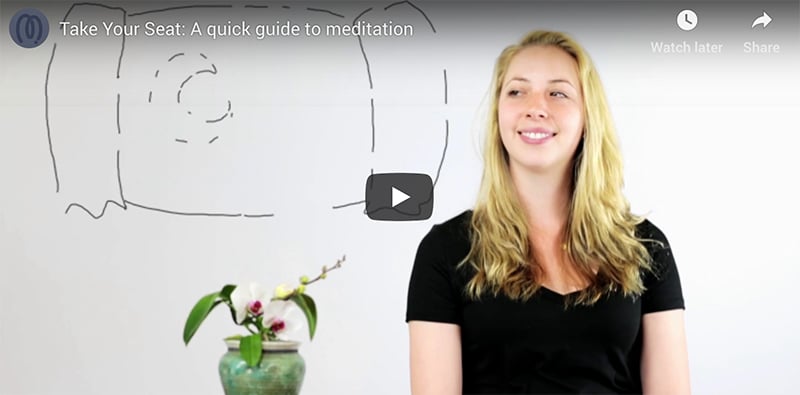Top 5 Buddhist Meditation Postures
Category: Buddhist Meditation | How to Meditate | Meditation Posture | Popular

Meditation is a calming process that allows you to center yourself and joyfully experience the present moment. There are many meditation postures that you could try; most of them are easy to achieve. A good Buddhist meditation posture should be comfortable. You shouldn’t have to strain your body to execute a particular pose. Fundamentally, although it does take time to get used to sitting still, mind and body should be at ease, dignified and alert.
Here are four factors to consider before adopting any meditation posture:
- Comfort. During your meditation session, you’ll be training in mindfulness. You don’t want unnecessary physical pain to become a major distraction when you’re on the cushion or leave its mark on you when the session is over. The meditation posture you choose should be comfortable enough to allow you to sit mindfully without the angst of pain.
- Stillness. Let your body achieve a sense of stability and balance as you settle into your practice. You can find your balance by gently rocking your body forward, backward, then side to side (like a pendulum) until you’ve found your meditation posture sweet spot. Once you’ve found it, try to stay there.
- Relaxation. For most people, meditation naturally releases tension. Check in with your body when you sit: your neck, face and shoulder muscles shouldn’t be tense. Your arms should feel relaxed, your hands gently resting on your knees or lap. Relax your legs as well. If sitting in meditation is new for you, be careful not to hurt your knees by imposing a posture that feels wrong. If you’re on a cushion, let your knees touch the ground or support them with pillows. When possible, your hips should be a bit higher than your knees; use a cushion or pad if necessary.
- Alignment. As you settle into your favorite meditation posture, remember that your back should be as aligned as is comfortably possible. It may help to imagine that your entire spine is a stack of coins. If you lean too much in any direction, the coins will inevitably tumble over.
Remember, every body is different – use your common sense to find a posture that works for you. In all of these poses except the “corpse pose” where you’re lying down, you’ll be sitting with your back straight and your hands either in the meditation position – right hand on the left with your two thumbs touching, held at the level of your navel or a bit below – or gently resting on your thighs above the knees. Your back should feel aligned and your eyes should be half-closed with the gaze directed down in front of you.
Here are 5 tried and true Buddhist meditation postures
- The Burmese Position
If you’d like to practice on a cushion or mat (rather than a chair or bench) and want an accessible pose, the “Burmese” position might be just right for you. Here, you simply sit on a mat, with a cushion if needed, bend your legs with the right foot on the outside, and pull your feet gently towards your pelvis. Ideally the tops of your feet are touching the mat.
- The Lotus Position
There are basically three types of lotus meditation postures: the quarter lotus, the half lotus and the full lotus.
The quarter lotus position is relatively simple. While sitting on a cushion, pillow or mat, you “cross” your legs by placing your right foot on your left calf. Make sure your knees are lower than your hips. This pose is highly recommended.
The half lotus takes the quarter lotus a step further. Here again, the left foot is close to the pelvis but the right foot is closer to the trunk than with the quarter lotus and rests on the left thigh.
The full lotus is quite challenging until you get the hang of it – which may or may not happen depending on how limber you are. You start with your right foot on your left thigh and then bring your left foot up to your right thigh. It feels pretzel-like at first, but meditators and yoga buffs who are comfortable with this posture find that it naturally supports their alignment and meditation.
- The Seiza Position
Meditating while kneeling is also an option. In Japan, the seiza pose is a popular Zen Buddhist meditation posture that involves kneeling on a mat. The use of a pillow, cushion or meditation bench under the buttocks helps support the spine and takes pressure off of the knees.
- Sitting on a chair
There are many reasons why you may prefer sitting on a chair – comfort, flexibility, sore knees, mobility, etc. This posture is comfortable since it doesn’t strain the knees or legs. It’s best to sit up straight rather than lean on the chair since this promotes alignment. Place the feet flat on the floor about a foot or so apart. Here again it’s better if the hips are a bit higher than the thighs and knees, and you shouldn’t be slouching. A thin cushion under the buttocks and/or pillow between the chair and the small of your back can help.
Another advantage of this posture is that you can easily spend a few minutes meditating at your desk, in the subway or on a park bench without attracting undue attention. Curiously, Buddhist texts represent the Buddha of the future seated on a chair. Yes, even on a chair you can experience how to sit properly in meditation.
- Corpse pose
Also called sarvasana, this very relaxing meditation posture is traditionally practiced at the end of a yoga session. You lie flat on your back facing upwards, stretch your hands loosely on the ground, close your eyes and concentrate on your breathing. The corpse pose can be helpful for individuals who have back issues. While easy on the body, this position naturally induces drowsiness; it requires an extra effort to maintain vigilance when you’re lying down. The corpse pose can also be used to relax tired muscles between periods of sitting.
These five positions are great meditation postures for beginners and more experienced meditators alike. In order to explore how to experience Buddhist meditation, choose a posture that ensures that you’re comfortable. It’s better to maintain a comfortable posture for 15 minutes than to endure a whole hour of pain. Take a look at our companion article the Best Meditation Posture for You.
Remember, anyone can meditate! For more information on how to start, check out our Beginner’s Guide to Meditation or take our free online course in learning to meditate.
Watch the following Take Your Seat video from Mindworks online mindfulness courses for instructions on how to find a comfortable posture for sitting meditation.







